Jinrui Zhang
$\mathcal{P}^3$: Toward Versatile Embodied Agents
Aug 09, 2025Abstract:Embodied agents have shown promising generalization capabilities across diverse physical environments, making them essential for a wide range of real-world applications. However, building versatile embodied agents poses critical challenges due to three key issues: dynamic environment perception, open-ended tool usage, and complex multi-task planning. Most previous works rely solely on feedback from tool agents to perceive environmental changes and task status, which limits adaptability to real-time dynamics, causes error accumulation, and restricts tool flexibility. Furthermore, multi-task scheduling has received limited attention, primarily due to the inherent complexity of managing task dependencies and balancing competing priorities in dynamic and complex environments. To overcome these challenges, we introduce $\mathcal{P}^3$, a unified framework that integrates real-time perception and dynamic scheduling. Specifically, $\mathcal{P}^3$ enables 1) \textbf Perceive relevant task information actively from the environment, 2) \textbf Plug and utilize any tool without feedback requirement, and 3) \textbf Plan multi-task execution based on prioritizing urgent tasks and dynamically adjusting task order based on dependencies. Extensive real-world experiments show that our approach bridges the gap between benchmarks and practical deployment, delivering highly transferable, general-purpose embodied agents. Code and data will be released soon.
Learning Speaker-Invariant Visual Features for Lipreading
Jun 09, 2025Abstract:Lipreading is a challenging cross-modal task that aims to convert visual lip movements into spoken text. Existing lipreading methods often extract visual features that include speaker-specific lip attributes (e.g., shape, color, texture), which introduce spurious correlations between vision and text. These correlations lead to suboptimal lipreading accuracy and restrict model generalization. To address this challenge, we introduce SIFLip, a speaker-invariant visual feature learning framework that disentangles speaker-specific attributes using two complementary disentanglement modules (Implicit Disentanglement and Explicit Disentanglement) to improve generalization. Specifically, since different speakers exhibit semantic consistency between lip movements and phonetic text when pronouncing the same words, our implicit disentanglement module leverages stable text embeddings as supervisory signals to learn common visual representations across speakers, implicitly decoupling speaker-specific features. Additionally, we design a speaker recognition sub-task within the main lipreading pipeline to filter speaker-specific features, then further explicitly disentangle these personalized visual features from the backbone network via gradient reversal. Experimental results demonstrate that SIFLip significantly enhances generalization performance across multiple public datasets. Experimental results demonstrate that SIFLip significantly improves generalization performance across multiple public datasets, outperforming state-of-the-art methods.
$γ$-FedHT: Stepsize-Aware Hard-Threshold Gradient Compression in Federated Learning
May 18, 2025Abstract:Gradient compression can effectively alleviate communication bottlenecks in Federated Learning (FL). Contemporary state-of-the-art sparse compressors, such as Top-$k$, exhibit high computational complexity, up to $\mathcal{O}(d\log_2{k})$, where $d$ is the number of model parameters. The hard-threshold compressor, which simply transmits elements with absolute values higher than a fixed threshold, is thus proposed to reduce the complexity to $\mathcal{O}(d)$. However, the hard-threshold compression causes accuracy degradation in FL, where the datasets are non-IID and the stepsize $\gamma$ is decreasing for model convergence. The decaying stepsize reduces the updates and causes the compression ratio of the hard-threshold compression to drop rapidly to an aggressive ratio. At or below this ratio, the model accuracy has been observed to degrade severely. To address this, we propose $\gamma$-FedHT, a stepsize-aware low-cost compressor with Error-Feedback to guarantee convergence. Given that the traditional theoretical framework of FL does not consider Error-Feedback, we introduce the fundamental conversation of Error-Feedback. We prove that $\gamma$-FedHT has the convergence rate of $\mathcal{O}(\frac{1}{T})$ ($T$ representing total training iterations) under $\mu$-strongly convex cases and $\mathcal{O}(\frac{1}{\sqrt{T}})$ under non-convex cases, \textit{same as FedAVG}. Extensive experiments demonstrate that $\gamma$-FedHT improves accuracy by up to $7.42\%$ over Top-$k$ under equal communication traffic on various non-IID image datasets.
MobiFuse: A High-Precision On-device Depth Perception System with Multi-Data Fusion
Dec 18, 2024



Abstract:We present MobiFuse, a high-precision depth perception system on mobile devices that combines dual RGB and Time-of-Flight (ToF) cameras. To achieve this, we leverage physical principles from various environmental factors to propose the Depth Error Indication (DEI) modality, characterizing the depth error of ToF and stereo-matching. Furthermore, we employ a progressive fusion strategy, merging geometric features from ToF and stereo depth maps with depth error features from the DEI modality to create precise depth maps. Additionally, we create a new ToF-Stereo depth dataset, RealToF, to train and validate our model. Our experiments demonstrate that MobiFuse excels over baselines by significantly reducing depth measurement errors by up to 77.7%. It also showcases strong generalization across diverse datasets and proves effectiveness in two downstream tasks: 3D reconstruction and 3D segmentation. The demo video of MobiFuse in real-life scenarios is available at the de-identified YouTube link(https://youtu.be/jy-Sp7T1LVs).
LongVALE: Vision-Audio-Language-Event Benchmark Towards Time-Aware Omni-Modal Perception of Long Videos
Nov 29, 2024
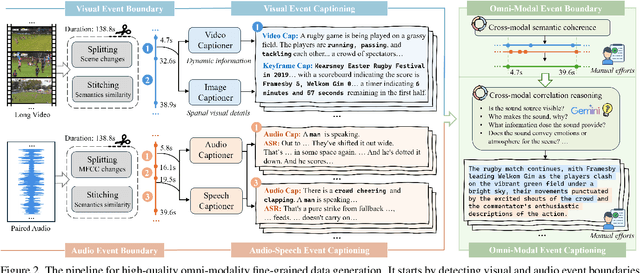

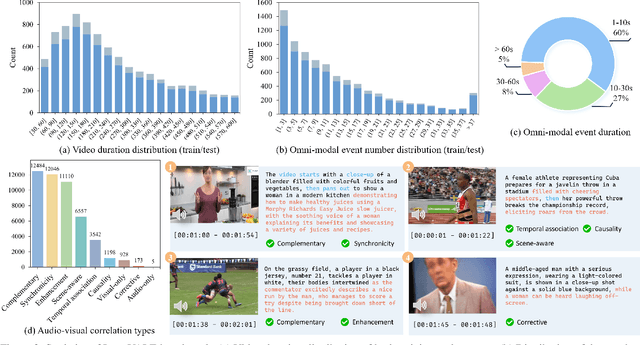
Abstract:Despite impressive advancements in video understanding, most efforts remain limited to coarse-grained or visual-only video tasks. However, real-world videos encompass omni-modal information (vision, audio, and speech) with a series of events forming a cohesive storyline. The lack of multi-modal video data with fine-grained event annotations and the high cost of manual labeling are major obstacles to comprehensive omni-modality video perception. To address this gap, we propose an automatic pipeline consisting of high-quality multi-modal video filtering, semantically coherent omni-modal event boundary detection, and cross-modal correlation-aware event captioning. In this way, we present LongVALE, the first-ever Vision-Audio-Language Event understanding benchmark comprising 105K omni-modal events with precise temporal boundaries and detailed relation-aware captions within 8.4K high-quality long videos. Further, we build a baseline that leverages LongVALE to enable video large language models (LLMs) for omni-modality fine-grained temporal video understanding for the first time. Extensive experiments demonstrate the effectiveness and great potential of LongVALE in advancing comprehensive multi-modal video understanding.
Differential Informed Auto-Encoder
Oct 24, 2024Abstract:In this article, an encoder was trained to obtain the inner structure of the original data by obtain a differential equations. A decoder was trained to resample the original data domain, to generate new data that obey the differential structure of the original data using the physics-informed neural network.
MultiCounter: Multiple Action Agnostic Repetition Counting in Untrimmed Videos
Sep 06, 2024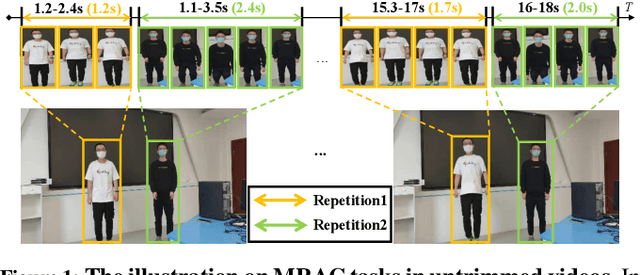


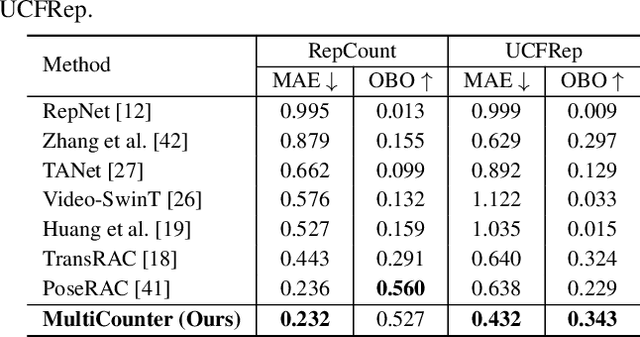
Abstract:Multi-instance Repetitive Action Counting (MRAC) aims to estimate the number of repetitive actions performed by multiple instances in untrimmed videos, commonly found in human-centric domains like sports and exercise. In this paper, we propose MultiCounter, a fully end-to-end deep learning framework that enables simultaneous detection, tracking, and counting of repetitive actions of multiple human instances. Specifically, MultiCounter incorporates two novel modules: 1) mixed spatiotemporal interaction for efficient context correlation across consecutive frames, and 2) task-specific heads for accurate perception of periodic boundaries and generalization for action-agnostic human instances. We train MultiCounter on a synthetic dataset called MultiRep generated from annotated real-world videos. Experiments on the MultiRep dataset validate the fundamental challenge of MRAC tasks and showcase the superiority of our proposed model. Compared to ByteTrack+RepNet, a solution that combines an advanced tracker with a single repetition counter, MultiCounter substantially improves Period-mAP by 41.0%, reduces AvgMAE by 58.6%, and increases AvgOBO 1.48 times. This sets a new benchmark in the field of MRAC. Moreover, MultiCounter runs in real-time on a commodity GPU server and is insensitive to the number of human instances in a video.
Reflective Instruction Tuning: Mitigating Hallucinations in Large Vision-Language Models
Jul 16, 2024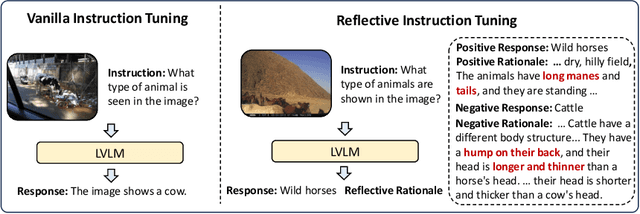

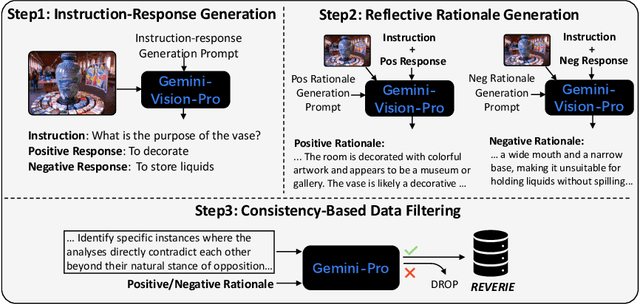

Abstract:Large vision-language models (LVLMs) have shown promising performance on a variety of vision-language tasks. However, they remain susceptible to hallucinations, generating outputs misaligned with visual content or instructions. While various mitigation strategies have been proposed, they often neglect a key contributor to hallucinations: lack of fine-grained reasoning supervision during training. Without intermediate reasoning steps, models may establish superficial shortcuts between instructions and responses, failing to internalize the inherent reasoning logic. To address this challenge, we propose reflective instruction tuning, which integrates rationale learning into visual instruction tuning. Unlike previous methods that learning from responses only, our approach entails the model predicting rationales justifying why responses are correct or incorrect. This fosters a deeper engagement with the fine-grained reasoning underlying each response, thus enhancing the model's reasoning proficiency. To facilitate this approach, we propose REVERIE, the first large-scale instruction-tuning dataset with ReflEctiVE RatIonalE annotations. REVERIE comprises 115k machine-generated reasoning instructions, each meticulously annotated with a corresponding pair of correct and confusing responses, alongside comprehensive rationales elucidating the justification behind the correctness or erroneousness of each response. Experimental results on multiple LVLM benchmarks reveal that reflective instruction tuning with the REVERIE dataset yields noticeable performance gain over the baseline model, demonstrating the effectiveness of reflecting from the rationales. Project page is at https://zjr2000.github.io/projects/reverie.
Ego3DPose: Capturing 3D Cues from Binocular Egocentric Views
Sep 21, 2023Abstract:We present Ego3DPose, a highly accurate binocular egocentric 3D pose reconstruction system. The binocular egocentric setup offers practicality and usefulness in various applications, however, it remains largely under-explored. It has been suffering from low pose estimation accuracy due to viewing distortion, severe self-occlusion, and limited field-of-view of the joints in egocentric 2D images. Here, we notice that two important 3D cues, stereo correspondences, and perspective, contained in the egocentric binocular input are neglected. Current methods heavily rely on 2D image features, implicitly learning 3D information, which introduces biases towards commonly observed motions and leads to low overall accuracy. We observe that they not only fail in challenging occlusion cases but also in estimating visible joint positions. To address these challenges, we propose two novel approaches. First, we design a two-path network architecture with a path that estimates pose per limb independently with its binocular heatmaps. Without full-body information provided, it alleviates bias toward trained full-body distribution. Second, we leverage the egocentric view of body limbs, which exhibits strong perspective variance (e.g., a significantly large-size hand when it is close to the camera). We propose a new perspective-aware representation using trigonometry, enabling the network to estimate the 3D orientation of limbs. Finally, we develop an end-to-end pose reconstruction network that synergizes both techniques. Our comprehensive evaluations demonstrate that Ego3DPose outperforms state-of-the-art models by a pose estimation error (i.e., MPJPE) reduction of 23.1% in the UnrealEgo dataset. Our qualitative results highlight the superiority of our approach across a range of scenarios and challenges.
Transferable Decoding with Visual Entities for Zero-Shot Image Captioning
Jul 31, 2023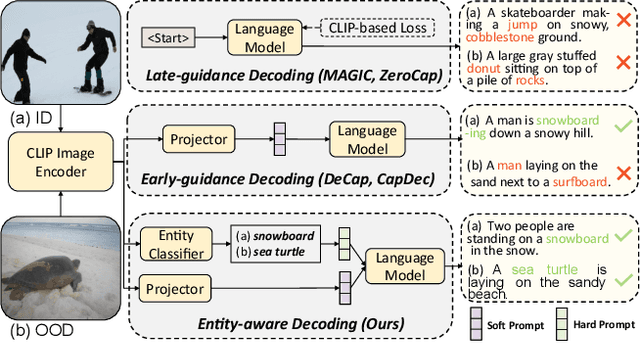


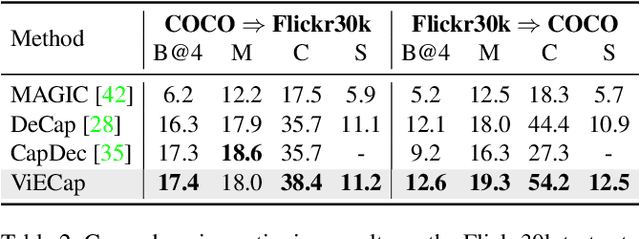
Abstract:Image-to-text generation aims to describe images using natural language. Recently, zero-shot image captioning based on pre-trained vision-language models (VLMs) and large language models (LLMs) has made significant progress. However, we have observed and empirically demonstrated that these methods are susceptible to modality bias induced by LLMs and tend to generate descriptions containing objects (entities) that do not actually exist in the image but frequently appear during training (i.e., object hallucination). In this paper, we propose ViECap, a transferable decoding model that leverages entity-aware decoding to generate descriptions in both seen and unseen scenarios. ViECap incorporates entity-aware hard prompts to guide LLMs' attention toward the visual entities present in the image, enabling coherent caption generation across diverse scenes. With entity-aware hard prompts, ViECap is capable of maintaining performance when transferring from in-domain to out-of-domain scenarios. Extensive experiments demonstrate that ViECap sets a new state-of-the-art cross-domain (transferable) captioning and performs competitively in-domain captioning compared to previous VLMs-based zero-shot methods. Our code is available at: https://github.com/FeiElysia/ViECap
 Add to Chrome
Add to Chrome Add to Firefox
Add to Firefox Add to Edge
Add to Edge